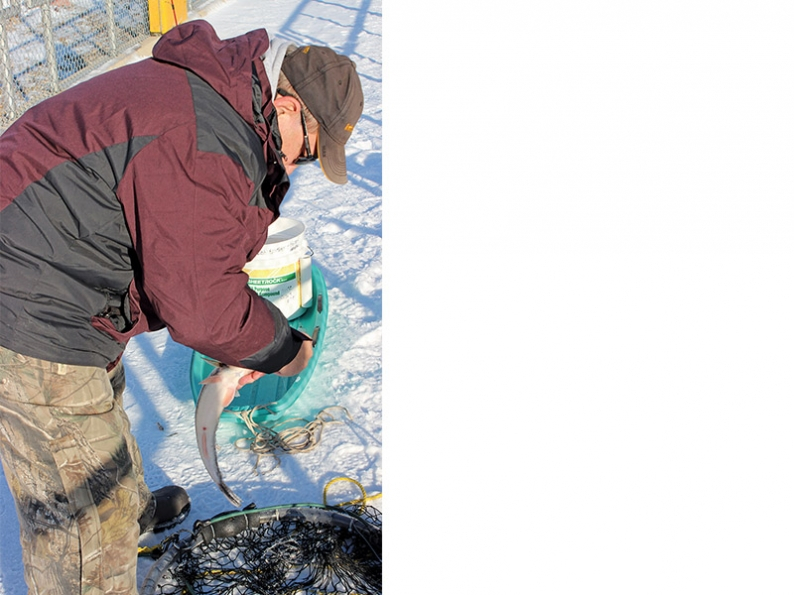
On any given day, a boat could slip into the Missouri River below Garrison Dam, head down river, and catch a walleye or two.
Oh, sure, during summer dozens and dozens of boats are common in the chutes, tailrace, and down river. But the quirky thing about Dakota anglers is that they don’t let a little thing like winter deter them from river fishing.
During any normal -- not that there’s anything normal about any North Dakota winter -- it’s not unusual to see a boat or two dotting the Missouri River downstream of the U.S. Army Corps of Engineers tailrace boat ramp. Weather permitting, that is.
It’s just that in the winter anglers have to take a few extra precautions: Little things like strapping down a Mr. Heater, handy to occasionally warm one’s feet and hands.
Always -- and that can’t be emphasized enough -- always, wear a life jacket when on the river. Winter fishing, though, makes it especially important.
Also, while ND Game and Fish Department requirements designed to reduce the potential spread of aquatic nuisance species require emptying one’s boat of water before leaving a water body, that’s an absolute must in the winter, Scott Hobbs, Scott’s Bait and Tackle owner in Pick City, stressed. Failure to do so will likely crack a boat motor’s lower unit when water freezes, especially on larger boats with bigger, deeper lower units. Hobbs also reminded anglers not to put water in their livewells in winter cold.
Hobbs also has tidbits and tips concerning the boat ramp itself in the winter: Depending on weather, at times it might be encased in ice with slack water away from the chutes potentially icing in around the ramp area even if the river itself is wide open.
In addition, Garrison Dam releases fluctuate, depending on the amount of water flowing through release tunnels from the dam’s hydropower plant as it produces electricity. Just because daily average water releases may be at 16,000 or 18,000 cfs for example, doesn’t mean that’s a consistent rate of flow. Sometimes, getting a boat in the river can be difficult because of low releases or ice, making it difficult or impossible to get down river.
Just as winter access to ice-fish on lakes in North Dakota doesn’t come with a guarantee that anglers can get to their favorite ice-fishing spot, there’s no guarantee anglers can get their boat in at the tailrace ramp in winter, whether it’s low water or ice.
The ramp itself can become icy, as vehicles pull boats and trailers from the water, leaving a slithering layer of ice on the concrete ramp itself. That’s an accident waiting to happen, slipping and sliding on the icy ramp, let alone trying to get traction with a vehicle.
“Use some common sense at the ramp,” Hobbs emphasized.
Despite unique challenges of open-water fishing in temperatures below freezing, Hobbs said boats could be fishing down river of the tailrace on any given day -- especially if the wind isn’t howling -- any month of the year. Mother Nature permitting, that is.
Winter techniques mirror summer techniques, Hobbs described.
“It’s minnows and jig fishing,” he added, with most anglers anchoring down river around the first or second coal veins and near stumps in the winter. Jig size varies with the amount of current. “Normally, you just want to feel the jig.”
His advice is start with a light, 1/4-ounce jig and 4- or 6-lb. test line and experiment from there with jig size.
It’s important to realize that water below the dam is ultra-clear in winter, visibility easily to the 10-foot mark in many places. Fish are spooky. As a result, jigs with bright colors should be avoided. Veteran anglers use unpainted jigs, as well as a live bait rig, which consists of a sliding sinker a couple feet above a plain hook, tipped with two minnows. Anchor, cast and retrieve slowly, making sure the rig stays on the bottom. It’s often finesse fishing.
The tailrace “chutes”, directly below the dam, typically have less activity in winter, especially considering the combination of colder winter temperatures and stronger current.
Shore-fishing along the tailrace boat ramp rocks is also popular year-around, weather permitting. Casting crankbaits from shore along the rocks is a staple anytime of the year.
Another tip: Cast crankbaits away from any ice where they could get caught. If the lure does catch on ice, don’t go onto the ice attempting to retrieve it. No crankbait is worth breaking through into water.
And just as the tailrace boat ramp can ice in with low water and cold temperatures, shore-fishing can be curtailed under those same conditions. Rocks can be slippery and icy, as well.
The winter of 2015-2016 brought numerous anglers to the river, Hobbs said, with the unseasonably warm weather. Just how many anglers will be out anytime during January and into the early months of the new year depends on tailrace boat ramp access and temperatures.
But with an extra cautious, safety-conscious approach, extra gloves, warm clothing, a Mr. Heater, and cooperation in the form of calm and sunny skies, people driving on US Highway 83 or ND Highway 200 shouldn’t be too surprised if they see someone pulling a boat, heading to the Missouri River tailrace below Garrison Dam during winter.
The potential wildlife display is another advantage of winter fishing on the Missouri River. If there isn’t too much snow so waterfowl can still feed on open fields surrounding the river and Lake Sakakawea, anglers could enjoy watching an array of hardy duck species and Canada geese, as well as opportunistic bald and golden eagles as they winter along the river’s open water.
Winter in the Dakotas doesn’t diminish anglers’ desire to catch fish. •